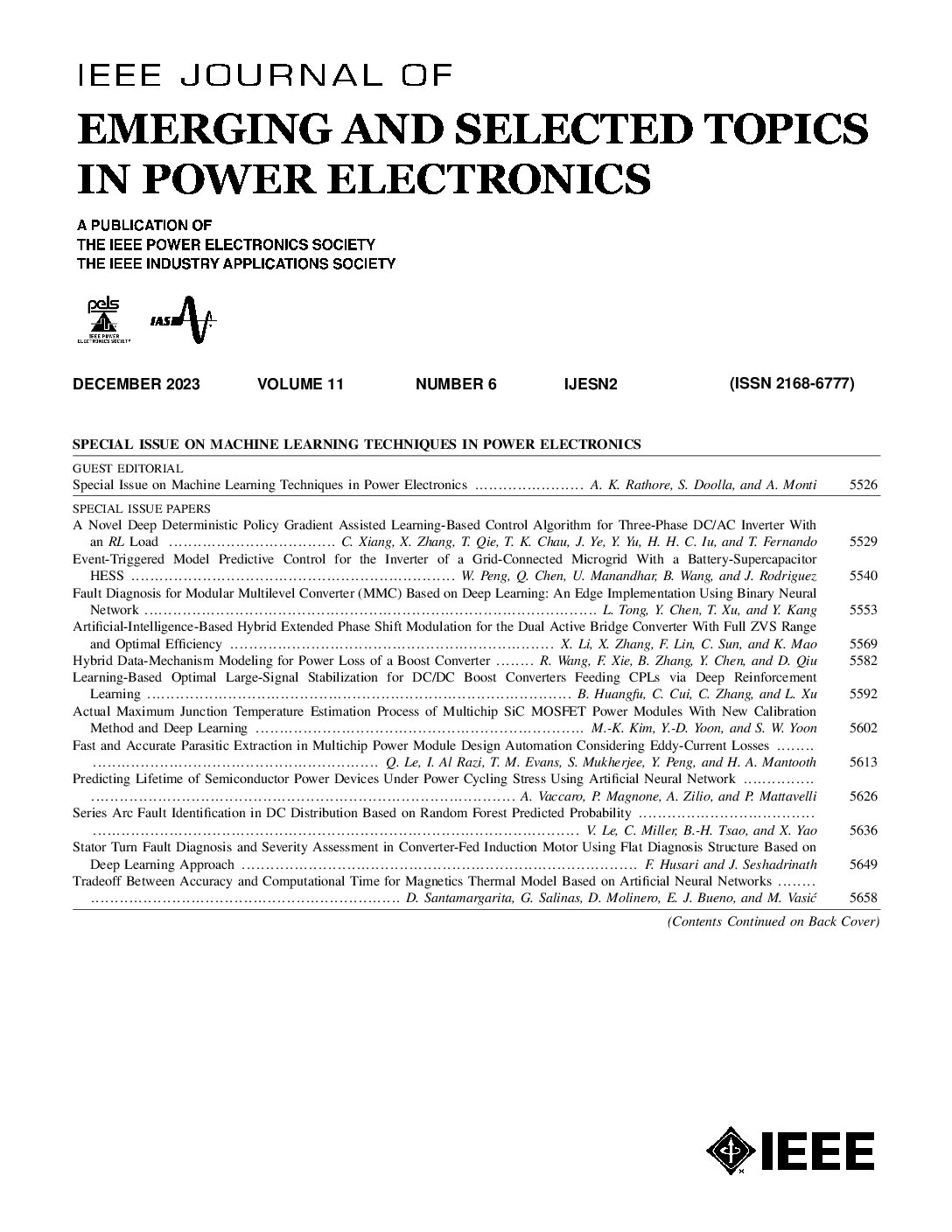模块化多电平变换器电池储能系统的低电流THD扩展电平模型预测控制方法
IF 4.9
2区 工程技术
Q1 ENGINEERING, ELECTRICAL & ELECTRONIC
IEEE Journal of Emerging and Selected Topics in Power Electronics
Pub Date : 2025-03-10
DOI:10.1109/JESTPE.2025.3549824
引用次数: 0
摘要
模块化多级变换器-电池储能系统(MMC-BESS)是一种具有提高电网可靠性潜力的变换器系统。然而,在MMC-BESS中实现模型预测控制(MPC)面临着计算量大、输出电流质量次优以及权重因子选择等挑战。针对这些挑战,本文提出了一种扩展级MPC方法,即在负载MPC阶段直接计算输出电压参考值,然后通过逐步优化的方法对输出电平进行优化。此外,它采用了成本函数,优化电流面积,进一步降低总谐波失真(THD)。值得注意的是,该过程确保每个控制周期的计算复杂度为5,与子模块的数量无关。采用两种控制策略,根据插入子模块的数量优化循环电流控制。使用独立的输出电流和循环电流成本函数消除了对加权因子的需要,而用于平衡荷电状态(SoC)的循环电流反馈被纳入循环电流参考,以实现相间和桥臂SoC平衡控制。仿真和实验结果验证了该方法的有效性。本文章由计算机程序翻译,如有差异,请以英文原文为准。
An Extended-Level Model Predictive Control Method With Reduced Current THD for Modular Multilevel Converter-Battery Energy Storage System
The modular multilevel converter-battery energy storage system (MMC-BESS) is a converter system with the potential to enhance grid reliability. However, the implementation of model predictive control (MPC) in MMC-BESS is confronted with challenges such as substantial computational demands, suboptimal quality of output current, and challenges in selecting weighting factors. To address these challenges, this article puts forward an extended-level MPC approach, which involves the direct calculation of the output voltage reference value in the load MPC stage, followed by the optimization of the output level through a step-by-step optimization method. Additionally, it employs a cost function that optimizes the current area to further reduce the total harmonic distortion (THD). Notably, this process ensures a computational complexity of 5 for each control cycle, independent of the number of submodules. Two control strategies are employed to optimize the circulating current control depending on the number of inserted submodules. The use of independent cost functions for output current and circulating current eliminates the need for weighting factors, while the circulating current feedback for balancing the state-of-charge (SoC) is incorporated into the circulating current reference to achieve interphase and bridge arm SoC balancing control. The effectiveness of the proposed method is validated by simulation and experimental results.
求助全文
通过发布文献求助,成功后即可免费获取论文全文。
去求助
来源期刊

IEEE Journal of Emerging and Selected Topics in Power Electronics
ENGINEERING, ELECTRICAL & ELECTRONIC-
CiteScore
12.50
自引率
9.10%
发文量
547
审稿时长
3 months
期刊介绍:
The aim of the journal is to enable the power electronics community to address the emerging and selected topics in power electronics in an agile fashion. It is a forum where multidisciplinary and discriminating technologies and applications are discussed by and for both practitioners and researchers on timely topics in power electronics from components to systems.
 求助内容:
求助内容: 应助结果提醒方式:
应助结果提醒方式:


